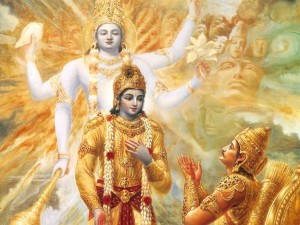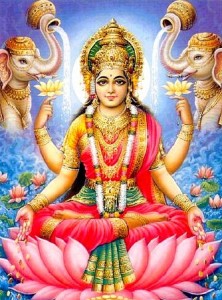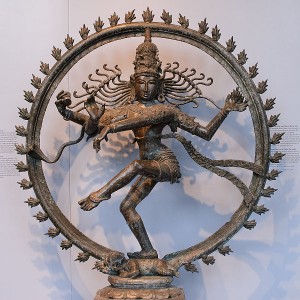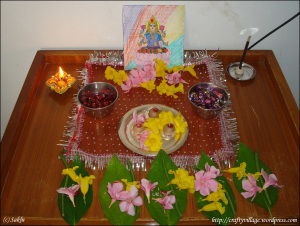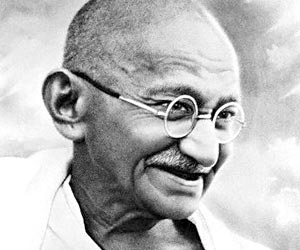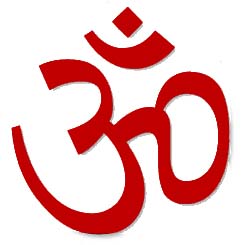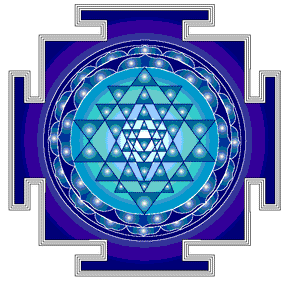Hinduism
While Hindus are trying to achieve Moksha (enlightenment) just as much as the Buddhists try to achieve Nirvana, there is not as much emphasis on individual suffering or rejecting the world. In order to achieve Moksha, one must understand the supreme reality in the world. There are different ways to do this, unlike in Buddhism where there is only one way. Some achieve Moksha through yoga, of which there are four forms to help the devotee attain enlightenment. They are: Bhakti (the way of devotion), Karma (the way of action), Jnana (the way of knowledge), and Raja (the eighfold path of the Yoga Sutras of Patanjali). Another way to achieve Moksha is by removing ignorance and instead understanding that the world is unreal and impermanent (Advaita Vedanta tradition). In the Dvaita tradition, Moksha is oneness with God (Vishnu). There is no set path to achieve this oneness because every soul is different and so requires something different in order to be one with Vishnu. In the Vedanta tradition, there are three ways to achieve Moksha: strict non-duality (all things are one and so are equal); a less strict non-duality (most things are one and so are equal, but there are some things that should be [or are] on another level); and duality (all things are on two levels instead of one).
Source: http://en.wikipedia.org/wiki/Moksha
Ends of Life
How to attain enlightenment:
- Pursuit of dharma- duty; order
- Artha- wealth and worldly satisfaction
- Kama- desire; pleasure
- Moksha- end of samsara
Religious Texts:
-Vedas*: Artharva, Sama, Yajur, Rig
- Gives an account of creation – not too concerned with whence things originated.
- Hymns in praise of gods
- How to give a proper sacrifice
- Each Veda includes four layers (but not in equal amounts):
- Samhitans – hymns used in sacrificial ritual
- Brahmanas- reflections on the ritual
- Aranyakas- develop the Brahmanical material
- Upanishads- commentaries
- There is not a fixed canon of what text belongs and what text does not belong.
- It is difficult to date the Vedas because they were not written down for many, many years.
- Shruti- hearing; a body of Vedic literature that has had limited accessibility (until recently).
- Smriti- learning or remembered texts; mostly consists of epics, puranas, and dharmashastras; these are open to all.
- Mantas- formulas for chanting.
- Women could not learn the Vedas until recently. They can now chant the Vedas, but only in private or in places that have a limited public.
-Rig Veda:
- Cosmology- something stirs; this realm is below something because “the one who looks down on it…”; there is more than one heaven (“highest heaven”).
–Fifth Veda (the Epics);
- Mahabarata
- Ramayana
-Bhagavad-Gita: the song of god (Krishna) found in the Mahabharata. It focuses on the Bhakti, Dharma, and Karma of one of the main characters, Prince Arjuna. He has to make a difficult decision between killing traitors to the Kingdom, which include his mentor and a relative, and allowing them and their army to live. Krishna guides Arjuna by telling him that it is his dharma (duty) to destroy the army and it will not hurt his karma because the souls of the traitor army have already been claimed by Shiva. Arjuna is simply killing the fleshly bodies of the traitors.
Source: http://www.hinduhumanrights.info/why-did-krishna-choose-arjuna-instead-of-karna-drona-o-bhishma/
-Brahmans speak the Vedas and Upanishads. They teach the texts to their students and the students memorize the texts in order to pass on the oral tradition.
*These texts were composed orally during the Vedic Period (circa 1500-700 B.C.E.)
Deities:
Vedic Period (1500-700 B.C.E.)
- Pursha
- The cosmic man sacrificed by the gods to the gods
- The head represents the Brahmans, arms the warriors, stomach/abs the producers and craftspeople, and the feet represent the servants. Dalits are not depicted.
- Indra
- Agni
- fire
- Soma
- a type of hallucination that is part of a way to get to different states of consciousness.
Classical Period (750 B.C.E.–1000 C.E.)
- Vishnu
- Practitioners are called Vaishnava
- Ritual sacrifice is associated with him
- Has 10 Avatars, some of which are: Krishna, Rama (King and slayer of demon Ravana; the hero of the Ramayana), Narasimba (half-man, half-lion), Vamana (dwarf avatar; slayed the demon Bali), and Kalki (the tenth and final avatar who has yet to come).
Source: http://www.photoandwallpapers.com/lord-vishnu/
- Shiva
- Practitioners are called Shaiva
- Four Ashramas (stages) – student, householder, forest dweller, renouncer
- Lord of destruction
- Devi
- Female (goddess)
- Practitioners are called Deui/Shakta
- Four Aims of life
- Yoga
Source: http://www.shrivitthal.com/events/shri-devi-mahalakshmi-upasana/
- Krishna
- One reincarnation of Vishnu
- Shiva Nataraja
- Half male and half female
- Lord of the cosmic dance
- Ithifallic, but a maximization of power, not sex
Source: http://commons.wikimedia.org/wiki/File:WLANL_-_23dingenvoormusea_-_Shiva_Nataraja.jpg
- Yellamma
- Hindu goddess (manifestation of Devi) associated with Shiva
- Holds a trident
- Particularly concerned with the poor and those who suffer
- Has a cult following that is also sometimes associated with devadasis; the women are dedicated to the temple by their parents and are well-respected by most communities. The women also provide sexual activities for the male devotees. The females have no choice in the matter; they are brought to the temple at a very young age and raised to be a devadasi. They have power (they are the only ones who can perform certain rites and rituals), but others also have power over them. They are respected for being devotees to the goddess, but yet are reviled for being a sex worker.
Puja (worship)
-Includes offerings of:
- Sound
- Rice
- Water
- Flowers
- Powder
- Incense
- Light/lamps (offered with ghee – white stuff that appears when you boil butter)
- Fruit
Source: http://craftyvillage.wordpress.com/category/deepawali/
-These offerings require time and effort on the part of the devotee.
-The gods take the spiritual aspects of these items and the physical aspects, the leftovers if you will, are eaten or used by the devotees. Normally one would not eat another’s leftovers, unless they were of a higher caste than you, and since the gods are the highest in the caste system, everyone eats their ‘leftovers’.
-The gods that are sacrificed to include:
- Vishnu- the sustainer
- Krishna- an avatar of Vishnu
- Devi
- Ganesh- the remover of obstacles; Shiva’s son
- Lakshmi- the consort of Vishnu; goddess of wealth; Diwali (festival of lights) is devoted to her.
- Kali
Important Figures:
-Gandhi- wanted to get rid of the dalit caste level and have all people be equal. Gandhi advocated using the method of civil disobedience, like Martin Luther King, Jr., over the method of violence.
Source: http://www.thefamouspeople.com/profiles/mahatma-gandhi-55.php
-Many people in the Bhakti movement rejected the caste system, including:
- Kabir
- Ravidas – an ‘untouchable’ revered as a poet-saint
-Swami Vivekananda (1863-1902) – a disciple of Ramakrishna (a mystic of 19th century India). He attended the 1893 Parliament of World Religions conference where he:
- Presented Hinduism as a universal religion
- Advocated for reading the Vedas metaphorically rather than literally
- Helped to influence the transcendentalist movement
He also helped to revive Hinduism and make it a major world religion.
-Dayananda Saraswati (d. 1883) – formed the Arya Samaj, which called for a return to a pure Vedic religion. He wanted to get rid of non-Vedic texts and ideas as well as bring people back to Hinduism – a re-conversion.
Holidays*:
-Makar Sankranti (Pongal) – Occurs in the middle of January and is one of the most popular harvest festivals in Southern India. It marks the beginning of the sun’s journey northwards.
-Vasant Panchami- Celebrated in order to receive the blessing of the goddess of wisdom and the arts, Saraswati.
-Maha Shivaratri- “The great night of Shiva”; Shaiva fast and offer Bilva leaves to Shiva.
-Holi- A popular spring festival that celebrates the slaying of a demoness (Holika) by Lord Vishnu’s devotee Prahlad.
-Vasant Navratri- The Hindu festival of worship and dance.
-Rama Navami – Celebrates the birth of Rama.
-Gudi Padwa- Considered the beginning of the New Year by Marathis and the Konkanis. This is thought to be the day on which Brahma created the world.
-Ugadi- The beginning of the New Year for Kannadigas and Telugus. Celebrated on the same day as the Gudi Padwa, just has a different name.
-Hanuman Jayanti- Celebrates the birth of Rama’s loyal follower, Hanuman.
-Bihu- Celebrates the New Year according to the Assamese. It is the most popular Bihu festival.
-Sitalsasthi- A carnival which celebrates the marriage of Shiva and Parvati.
-Rath Yatra- Festival associated with Jagannath.
-Raja Parba- Four day long festival that welcomes the agricultural year.
-Krishna Janmaashtami- Celebrates the birth of Krishna.
-Radhastami- Celebrates the birth of the Goddess Radha.
-Vijayadashami- Celebrates the victory of good over evil.
-Prathamastami- Older females pray for their eldest child to be prosperous.
-Pancha Ganapati- Celebrates Lord Ganesha, the Lord of Categories.
*Source: http://en.wikipedia.org/wiki/Hindu_Holidays
Vocabulary:
-Dharma- the way/destiny; the all-encompassing way things are; devotion to and acceptance of duty; the state of the world.
-Dalit- “untouchable”.
-Mandir- a Hindu (or Jain) Temple.
-Puja- Hindu (and Jain) devotional worship; it can sometimes designate a festival devoted to a particular deity.
-Atman- self (also called Brahman); spirit.
-Rishis- seers; they saw the Vedas and passed them down orally (the Vedas were revealed to them); their descendants know the Vedas and the oral tradition is seen as more reliable than the written form.
-Mantra- creed; words you live by. There is power in the sound. Words/sounds that has power: Om/Aum; it is an all-encompassing sound.
Source: http://en.wikipedia.org/wiki/File:Om_hindu.jpg
-Samsara- cycle of birth, death, rebirth, etc.
-Karma- action; effects. Your karma determines your samsara (what role you live in next; if you have reached the end).
-Moksha- enlightenment; the end of samsara.
-Sannyasin- Renouncer; leave society; seek enlightenment in nature.
-Bhakti- Devotional Hindu worship.
-Shakti- Power. It is the feminine divine principle, which is always paired with a male divine principle, because the male and female need each other.
-Yantra- A geometric abstraction of a religious cult (the cult of Yellamma).
-RSS (Rashtriya Swayamsevak Sangh)- Hindu nationalist party in present-day India. They believe in Hindutva (Hinduness), which is not related to the religion Hinduism, but rather is seen as a part of the culture or nationality of India.
Source: http://www.isibrno.cz/~gott/mandalas.htm
-Darsham- viewing; the devotee can usually view the deity, but during puja the deity is also viewing the devotee.
-Bhagvan- term used in Hinduism to indicate a Supreme Being that possesses a personality; this Being/Deity is a personal one for the devotee.
-Devidasi- A ‘servant of the god(dess)’; in the cult of Yellamma, a young woman who acts as a temple prostitute.

